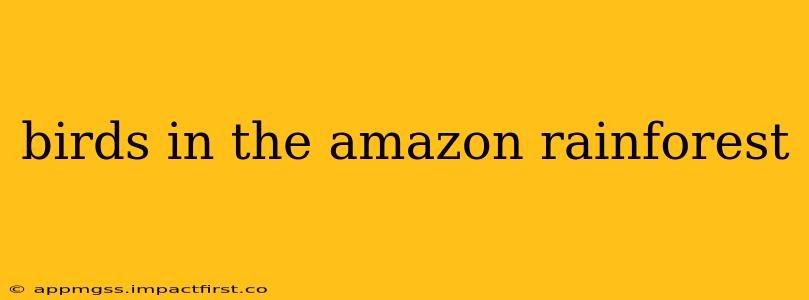The Amazon rainforest, a sprawling tapestry of emerald green, teeming with life, is arguably the most biodiverse place on Earth. And within this incredible ecosystem, the birds hold a particularly captivating place. From the smallest hummingbirds to the largest harpy eagles, the avian inhabitants of the Amazon paint the rainforest with a vibrant symphony of color, song, and flight. This exploration delves into the fascinating world of Amazonian birds, uncovering some of the unique species, their adaptations, and the threats they face.
How many bird species are in the Amazon rainforest?
This is a question that continues to fascinate ornithologists. Pinpointing an exact number is a monumental task, given the sheer size and remoteness of the rainforest. However, estimates suggest that over 1,300 bird species call the Amazon home, representing a significant portion of the world's avian diversity. This remarkable number highlights the rainforest's critical role as a global biodiversity hotspot. New species are still being discovered, underscoring the ongoing need for research and conservation efforts.
What are some of the most common birds in the Amazon?
While the Amazon boasts a staggering array of birdlife, certain species stand out due to their abundance and wide distribution. These include:
- Scarlet Macaws: These brilliantly colored parrots are iconic symbols of the Amazon, known for their striking red, yellow, and blue plumage.
- Amazon Kingfishers: These large, vibrant kingfishers are commonly seen perched along rivers and streams, diving for fish.
- Hoatzins: Also known as "reptile birds," these unique species possess clawed chicks that can climb trees.
- Toucans: With their oversized bills, toucans are instantly recognizable, displaying a variety of colors and patterns.
- Hummingbirds: The Amazon is home to a dazzling variety of hummingbird species, each with its own unique size, color, and feeding habits.
These are just a few examples; the sheer variety is breathtaking.
What are some of the rarest birds in the Amazon?
The Amazon’s remote and unexplored areas hide many secrets, including incredibly rare bird species. Many are poorly understood due to their elusive nature and limited sightings. Identifying specific "rarest" birds is challenging due to ongoing research and changes in population numbers. However, several species are considered critically endangered and warrant significant conservation concern. Examples include certain species of antbirds, cock-of-the-rocks and parrots. Precise identification of the absolute rarest requires ongoing research and updated field studies.
What are the threats to Amazonian birds?
Sadly, the future of these magnificent creatures is under threat. Deforestation, driven by agricultural expansion and logging, is the biggest threat. Habitat loss directly impacts bird populations, reducing their food sources and breeding grounds. Other threats include:
- Illegal wildlife trade: Many Amazonian bird species are targeted for the illegal pet trade.
- Climate change: Alterations in rainfall patterns and temperature can significantly disrupt ecosystems, impacting bird populations.
- Pollution: Pesticides and other pollutants can contaminate food sources and harm birds directly.
How can I help protect Amazonian birds?
Protecting Amazonian birds requires a multi-pronged approach:
- Support organizations working to conserve the Amazon rainforest: Many organizations are dedicated to protecting this vital ecosystem and its inhabitants. Financial contributions and volunteer efforts can make a significant difference.
- Reduce your carbon footprint: Climate change is a major threat; reducing your reliance on fossil fuels can help mitigate its impact.
- Educate yourself and others: Learn more about the Amazon rainforest and the challenges facing its birdlife, and share your knowledge with others.
- Support sustainable practices: Choose products made from sustainably harvested materials and support businesses committed to environmental protection.
The Amazon rainforest is a treasure trove of avian diversity, a testament to the wonders of nature. By understanding the threats facing these birds and taking action to protect their habitat, we can help ensure that future generations can marvel at the vibrant symphony of feathers that fills the Amazonian skies.
